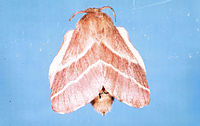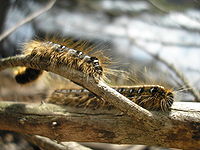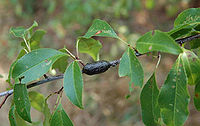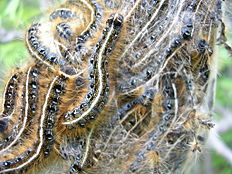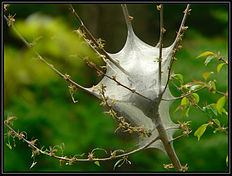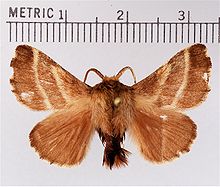- Eastern tent caterpillar
-
Eastern tent caterpillar 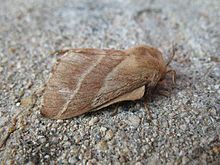
Adult 
Caterpillar on branch Conservation status WEScientific classification Kingdom: Animalia Phylum: Arthropoda Class: Insecta Order: Lepidoptera Family: Lasiocampidae Genus: Malacosoma Species: M. americanum Binomial name Malacosoma americanum
(Fabricius, 1793)Synonyms - Bombyx americana Fabricius, 1793
- Bombyx pensylvanica Guérin-Méneville, [1832]
- Clisiocampa decipiens Walker, 1855
- Bombyx frutetorum Boisduval, 1869
The Eastern tent caterpillar (Malacosoma americanum) is a univoltine, social species that forms communal nests in the branches of trees. It is sometimes confused with the gypsy moth, or the fall webworm and may be erroneously referred to as a bagworm which is the common name applied to unrelated caterpillars in the family Psychidae. The moths oviposit almost exclusively on trees in the plant family Rosaceae, particularly cherry (Prunus) and apple (Malus). The caterpillars are hairy with areas of blue, white, black and orange. The blue and white colors are structural colors created by the selective filtering of light by microtubules that arise on the cuticle.
Contents
Social species
In terms of complexity of interactions, the Tent Caterpillar stands near the pinnacle of caterpillar sociality. The adult moth lays her eggs in a single batch in late spring or early summer. The egg masses contain on average 200-300 eggs. Embryogenesis proceeds rapidly and within three weeks fully formed caterpillars can be found within the eggs. But the small caterpillars lie quiescent until the following spring, chewing their way through the shells of their eggs just as the buds of the host tree begin to expand.
The newly hatched caterpillars initiate the construction of a silk tent soon after emerging. They typically aggregate at the tent site for the whole of their larval life, expanding the tent each day to accommodate their increasing size. Under field conditions, the caterpillars feed three times each day, just before dawn, at mid-afternoon, and in the evening after sunset. During each bout of feeding the caterpillars emerge from the tent, add silk to the structure, move to distant feeding sites en masse, feed, then return immediately to the tent where they rest until the next activity period. When there is a major population of Eastern Tent caterpillars, they can be controlled fairly well and easily with no pesticides. The egg masses, shiny, reddish brown, and looking like dried foam are easy to spot, usually about 6 inches back from the tip of a thin twig on host plants - cherry, apple and rose. They are easily seen all through winter. The exception to this pattern of feeding occurs in the last instar when the caterpillars feed only at night. The caterpillars lay down pheromone trails to guide their movements between the tent and feeding sites. The insect has six larval instars. When fully grown, the caterpillars disperse and construct cocoons in protected places. The adult moths (imago) emerge about two weeks later. They are strictly nocturnal and start flying after nightfall, then possibly stop some hours before dawn.[1] Mating and oviposition typically occur on the same day as the moths emerge from their cocoons; the females die soon thereafter.
Tent caterpillars, like many other species of social caterpillars, vigorously thrash the anterior part of their bodies when they detect predators and parasitoids. Such bouts of thrashing, which may be initiated by a single caterpillar, radiate rapidly though the colony and may result in group displays involving dozens of caterpillars. Such displays create a moving target for tachinid flies, wasps and other small parasitoids that lay their eggs on or in the body of the caterpillar. They also clearly deter stink bugs and other timid predators. Groups of caterpillars resting on the surface of the tent constitute aposematic displays. Few birds other than the cuckoo find the hairy caterpillars palatable. The leaves of the cherry tree are cyanogenic and the caterpillars regurgitate cyanide-laden juices when disturbed.
Tents and temperature
The tent of the eastern tent caterpillar is among the largest built by any tent caterpillar. The tents are constructed in the crotch of the host tree and are typically oriented so that the broadest face of the structure faces the southeast, taking advantage of the morning sun. The caterpillars typically add silk to the structure at the onset of each of their daily activity periods. Silk is added directly to the surface of the tent as the caterpillars walk back and forth over the structure. The silk is laid down under slight tension and it eventually contracts, causing the newly spun layer of silk to separate from the previously spun layer. The tent thus consists of discrete layers separated by gaps within which the caterpillars rest. The tent has openings that allow the caterpillars to enter and exit the structure. Openings are formed where branches jut from the structure but are most common at the apex of the tent.
Light has a great effect on the caterpillars while they are spinning and they always spin the majority of their silk on the most illuminated face of the tent. Indeed, if under experimental conditions the dominant light source is directed at the tent from below, the caterpillars will build their tent upside down. Caterpillars continue to expand their tent until they enter the last phase of their larval life. The sixth-instar caterpillar conserves its silk for cocoon construction and adds nothing to the tent. The tents are multifunctional. They facilitate basking, offer some protection from enemies, provide for secure purchase, and act as a staging site from which the caterpillars launch en masse forays to distant feeding sites. The elevated humidity inside the tent may facilitate molting.
Eastern tent caterpillars are among the earliest of caterpillars to appear in the spring. Because the early spring weather is often cold, the caterpillars rely on the heat of the sun to elevate their body temperatures to levels that allow them to digest their food. Studies show that below 15 °C (59 °F) the caterpillars are unable to process the food in their guts. Early instars of the tent caterpillar are black and their bodies readily absorb the rays of the sun. When basking, the caterpillars typically pack together tightly, reducing heat loss due to convective currents. The long setae that occur on the caterpillars also serve to stem convective heat loss. The caterpillars may aggregate on the surface of the tent or within the structure. The tents act as miniature glass houses, trapping the heat of the morning sun and allowing the caterpillars to warm more quickly than they would if they remained outside the tent. Studies have shown that basking, aggregated caterpillars can achieve temperature excesses (Tbody−Tambient) of as much as 44 °C. Indeed, the caterpillars can easily overheat and they must take evasive action when they become too hot.
Because of its layered structure, the tent is thermally heterogeneous and the caterpillars can adjust their temperature by moving from layer to layer. The caterpillars may also aggregate on the outside of the shaded side of the tent and hang from the tips of their abdomens to enhance convective heat loss and cooling.
As has been shown for some other caterpillars, eastern tent caterpillars are capable of generating a small amount of metabolic heat while they digest their meals. When recently fed caterpillars pack tightly together, the temperature of the caterpillars in the interior of the mass may be several degrees Celsius above ambient temperature even in the absence of a radiant heat source. It is unclear whether this small heat gain has a significant effect on the rate of caterpillar growth.
Feeding
Tent caterpillars secrete silk from a spinneret wherever they go and frequently used pathways soon bear conspicuous silk trails. As the caterpillars move about the tree, they largely confine their movements to these trails. Curiously, it is not the silk that they follow but a pheromone trail secreted from the posterior tip of their abdomen. Caterpillars deposit exploratory trails by dragging the tip of their abdomen as they move over the tree in search of food. Caterpillars that find food and feed overmark the exploratory trails they follow back to the tent, creating recruitment trails. Recruitment trails are much more attractive to the caterpillars than exploratory trails and they serve to lead hungry caterpillars directly to the newest food finds. It is possible for a single successful forager to recruit the entire colony to its food find.
The exact identity of the trail pheromone of the eastern tent caterpillar has not yet been determined but the chemical 5β-cholestane-3-one has been shown to be fully competitive with the authentic trail pheromone. Caterpillars readily follow trails of this chemical, even abandoning their own trails in favor of artificial trails prepared with the compound.
The eastern tent caterpillar is of some importance as a plant pest since it may defoliate ornamental trees. Defoliated trees, however, rarely suffer significant damage and typically refoliate within several weeks. More seriously, the caterpillar has been implicated in Mare Reproductive Loss Syndrome (MRLS), but the exact mechanism by which the caterpillar triggers abortion in horses has yet to be determined. Many different theories have been proposed, but many scientists now believe that the hairs of the caterpillar act as tubes that, once puncturing the digestive tract, allow bacteria to escape into the uterus.
Toxicity
The eastern tent caterpillar has been linked to a phenomenon called 'Mare Reproductive Loss Syndrome' (MRLS). Experimental studies have shown that when pregnant mares are fed eastern tent caterpillars they abort. The caterpillars of this species often feed on the highly cyanogenic black cherry tree (Prunus serotina) and it was originally hypothesized that the mares were aborting in response to the cyanide they consumed along with the caterpillars. However, that hypothesis was disproven. In another study, the necropsy of a mare fed eastern tent caterpillars showed that fragments of the caterpillar's setae had embedded in the gut wall leading investigators to hypothesize that these invasive fragments may allow infective agents to pass into the animal's blood stream then travel to the placenta, initiating an abortive event. It remains to be determined whether this is indeed the cause of MRLS.
References
- ^ (Fullard & Napoleone 2001)
- Fitzgerald, Terrence D. (1995): The tent caterpillars. Cornell University Press.
- Fullard, James H. & Napoleone, Nadia (2001): Diel flight periodicity and the evolution of auditory defences in the Macrolepidoptera. Animal Behaviour 62(2): 349–368. doi:10.1006/anbe.2001.1753 PDF fulltext
External links
- Bagworm, Fall Webworm or Eastern Tent Caterpillar? August 18, 2001. Sandra Mason, University of Illinois Extension. Accessed May 31, 2010.
- Terrence D. Fitzgerald: The eastern tent caterpillar (Malacosoma americanum)
Categories:- Malacosoma
- Butterflies and moths of North America
Wikimedia Foundation. 2010.

